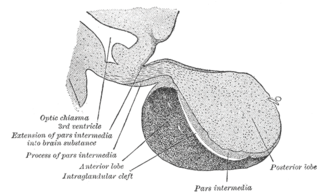
Endocrinology is a branch of biology and medicine dealing with the endocrine system, its diseases, and its specific secretions known as hormones. It is also concerned with the integration of developmental events proliferation, growth, and differentiation, and the psychological or behavioral activities of metabolism, growth and development, tissue function, sleep, digestion, respiration, excretion, mood, stress, lactation, movement, reproduction, and sensory perception caused by hormones. Specializations include behavioral endocrinology and comparative endocrinology.

The endocrine system is a chemical messenger system consisting of hormones, the group of glands of an organism that secrete those hormones directly into the circulatory system to regulate the function of distant target organs, and the feedback loops which modulate hormone release so that homeostasis is maintained. In humans, the major endocrine glands are the thyroid gland and the adrenal glands. In vertebrates, the hypothalamus is the neural control center for all endocrine systems. The study of the endocrine system and its disorders is known as endocrinology. Endocrinology is a branch of internal medicine.

Cushing's syndrome is a collection of signs and symptoms due to prolonged exposure to cortisol. Signs and symptoms may include high blood pressure, abdominal obesity but with thin arms and legs, reddish stretch marks, a round red face, a fat lump between the shoulders, weak muscles, weak bones, acne, and fragile skin that heals poorly. Women may have more hair and irregular menstruation. Occasionally there may be changes in mood, headaches, and a chronic feeling of tiredness.

The posterior pituitary is the posterior lobe of the pituitary gland which is part of the endocrine system. The posterior pituitary is not glandular as is the anterior pituitary. Instead, it is largely a collection of axonal projections from the hypothalamus that terminate behind the anterior pituitary, and serve as a site for the secretion of neurohypophysial hormones directly into the blood. The hypothalamic–neurohypophyseal system is composed of the hypothalamus, posterior pituitary, and these axonal projections.

Adrenal insufficiency is a condition in which the adrenal glands do not produce adequate amounts of steroid hormones, primarily cortisol; but may also include impaired production of aldosterone, which regulates sodium conservation, potassium secretion, and water retention. Craving for salt or salty foods due to the urinary losses of sodium is common.

Metyrapone, sold under the brand name Metopirone, is a medication which is used in the diagnosis of adrenal insufficiency and occasionally in the treatment of Cushing's syndrome (hypercortisolism).

Pituitary adenomas are tumors that occur in the pituitary gland. Pituitary adenomas are generally divided into three categories dependent upon their biological functioning: benign adenoma, invasive adenoma, and carcinomas. Most adenomas are benign, approximately 35% are invasive and just 0.1% to 0.2% are carcinomas. Pituitary adenomas represent from 10% to 25% of all intracranial neoplasms and the estimated prevalence rate in the general population is approximately 17%.

Endocrine glands are glands of the endocrine system that secrete their products, hormones, directly into the blood rather than through a duct. The major glands of the endocrine system include the pineal gland, pituitary gland, pancreas, ovaries, testes, thyroid gland, parathyroid gland, hypothalamus and adrenal glands. The hypothalamus and pituitary gland are neuroendocrine organs.
Neuroendocrine cells are cells that receive neuronal input and, as a consequence of this input, release message molecules (hormones) into the blood. In this way they bring about an integration between the nervous system and the endocrine system, a process known as neuroendocrine integration. An example of a neuroendocrine cell is a cell of the adrenal medulla, which releases adrenaline to the blood. The adrenal medullary cells are controlled by the sympathetic division of the autonomic nervous system. These cells are modified postganglionic neurons. Autonomic nerve fibers lead directly to them from the central nervous system. The adrenal medullary hormones are kept in vesicles much in the same way neurotransmitters are kept in neuronal vesicles. Hormonal effects can last up to ten times longer than those of neurotransmitters. Sympathetic nerve fiber impulses stimulate the release of adrenal medullary hormones. In this way the sympathetic division of the autonomic nervous system and the medullary secretions function together.
Neuroendocrinology is the branch of biology which studies the interaction between the nervous system and the endocrine system, that is how the brain regulates the hormonal activity in the body. The nervous and endocrine systems often act together in a process called neuroendocrine integration, to regulate the physiological processes of the human body. Neuroendocrinology arose from the recognition that the brain, especially the hypothalamus, controls secretion of pituitary gland hormones, and has subsequently expanded to investigate numerous interconnections of the endocrine and nervous systems.

Liddle's syndrome, also called Liddle syndrome is a genetic disorder inherited in an autosomal dominant manner that is characterized by early, and frequently severe, high blood pressure associated with low plasma renin activity, metabolic alkalosis, low blood potassium, and normal to low levels of aldosterone. Liddle syndrome involves abnormal kidney function, with excess reabsorption of sodium and loss of potassium from the renal tubule, and is treated with a combination of low sodium diet and potassium-sparing diuretics. It is extremely rare, with fewer than 30 pedigrees or isolated cases having been reported worldwide as of 2008.
Pseudo-Cushing's syndrome is a medical condition in which patients display the signs, symptoms, and abnormal hormone levels seen in Cushing's syndrome. However, pseudo-Cushing's syndrome is not caused by a problem with the hypothalamic-pituitary-adrenal axis as Cushing's is; it is mainly an idiopathic condition, however a cushingoid appearance is sometimes linked to excessive alcohol consumption. Elevated levels of total cortisol can also be due to estrogen found in oral contraceptive pills that contain a mixture of estrogen and progesterone. Estrogen can cause an increase of cortisol-binding globulin and thereby cause the total cortisol level to be elevated.

George P. Chrousos is professor of Pediatrics and Endocrinology Emeritus and former chairman of the Department of Pediatrics at the Athens University Medical School, Greece. Earlier he was senior investigator, director of the Pediatric Endocrinology Section and Training Program, and chief of the Pediatric and Reproductive Endocrinology Branch of the National Institute of Child Health and Human Development (NICHD), National Institutes of Health (NIH). He is also clinical professor of Pediatrics, Physiology and Biophysics at Georgetown University Medical School and distinguished visiting scientist, NICHD, NIH. Dr. Chrousos was the first general director of the Foundation of Biomedical Research of the Academy of Athens (2001–2002). He holds the UNESCO Chair on Adolescent Health Care, while he held the 2011 John Kluge Chair in Technology and Society, Library of Congress, Washington, D.C.
Frederic Crosby Bartter was an American endocrinologist best known for his work on hormones affecting the kidney and his discovery of syndrome of inappropriate antidiuretic hormone and Bartter syndrome. He had a separate interest in mushroom poisoning.
Hypothalamic disease is a disorder presenting primarily in the hypothalamus, which may be caused by damage resulting from malnutrition, including anorexia and bulimia eating disorders, genetic disorders, radiation, surgery, head trauma, lesion, tumour or other physical injury to the hypothalamus. The hypothalamus is the control center for several endocrine functions. Endocrine systems controlled by the hypothalamus are regulated by antidiuretic hormone (ADH), corticotropin-releasing hormone, gonadotropin-releasing hormone, growth hormone-releasing hormone, oxytocin, all of which are secreted by the hypothalamus. Damage to the hypothalamus may impact any of these hormones and the related endocrine systems. Many of these hypothalamic hormones act on the pituitary gland. Hypothalamic disease therefore affects the functioning of the pituitary and the target organs controlled by the pituitary, including the adrenal glands, ovaries and testes, and the thyroid gland.
Neena Betty Schwartz was an American endocrinologist and William Deering Professor of Endocrinology Emerita in the Department of Neurobiology at Northwestern University. She was best known for her work on female reproductive biology and the regulation of hormonal signaling pathways, particularly for the discovery of the signaling hormone inhibin. Schwartz was an active feminist advocate for women in science throughout her career; she was a founding member of the Association for Women in Science organization in 1971 and shared the founding presidency with Judith Pool. She also co-founded the Women in Endocrinology group under the auspices of the Endocrine Society, served terms as the president of the Endocrine Society and the Society for the Study of Reproduction, and was recognized for her exceptional mentorship of women scientists. In 2010, she wrote a memoir of her life in science, A Lab of My Own, in which she came out as lesbian.

Levoketoconazole, also known as (2S,4R)-ketoconazole, is a steroidogenesis inhibitor that is under development by Strongbridge Biopharma for the treatment of Cushing's syndrome. It is currently in phase III clinical trials for this indication. The drug is the levorotatory or (2S,4R) enantiomer of ketoconazole. It is expected to have greater potency, efficacy, and safety, including a lower risk of hepatotoxicity relative to racemic ketoconazole.
Claude Jean Migeon was a French pediatric endocrinologist who spent the majority of his career at the Johns Hopkins Hospital.
















